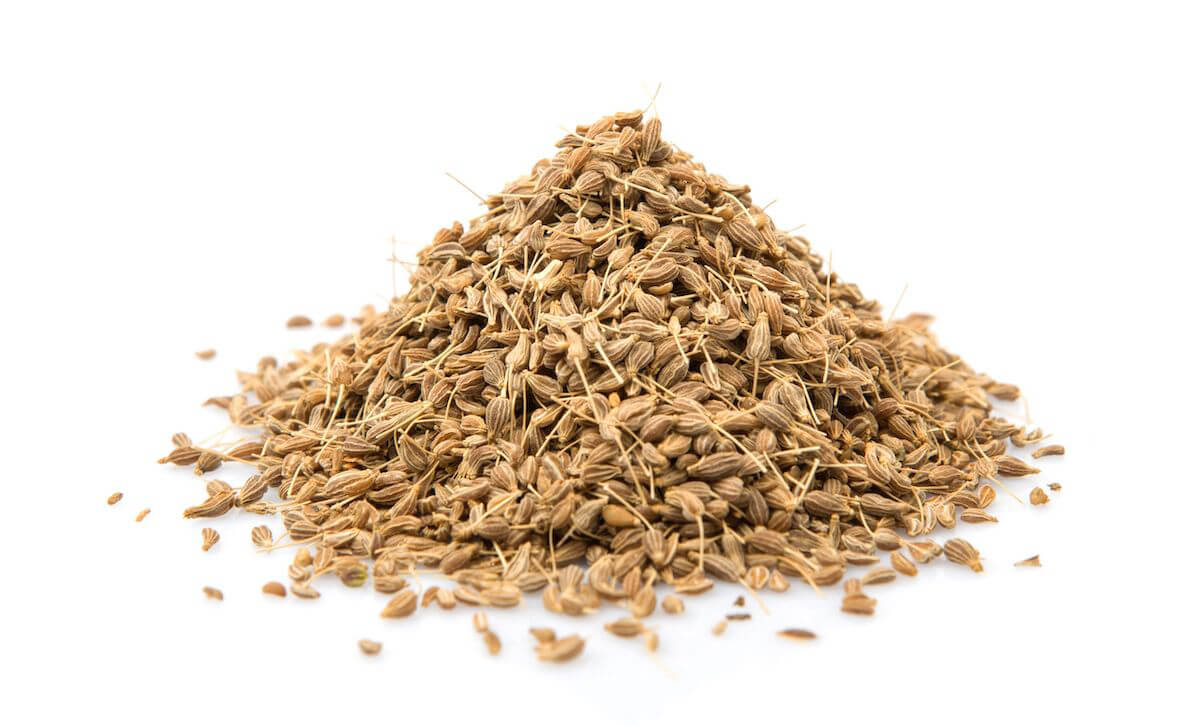Aniseed

In addition to giving a fine flavour to Christmas biscuits, aniseed is known to provide quick relief from digestive and respiratory ailments in horses and dogs. Aniseed's (Pimpinella anisum) healing properties are mainly found in the seeds' essential oils.
Where does aniseed come from, and what does it look like?
Aniseed was likely introduced to Greece from the Far East via Egypt; it is now cultivated worldwide in regions with mild climates. This herbaceous plant from the family Apiaceae can often be found growing wild on piles of rubble or in vineyards, sometimes up to 70 cm high. The leaves branch on the upper part of a round stem; the plant forms white flowering umbels between mid-June and late September. After flowering, the brown seeds ripen; these are botanically classified as dehiscent fruits. The grains are 4 to 5 mm in size, ovoid, ribbed, and with downy hairs.
Although the aniseed plant is identifiable by its typical aromatic anise scent, it is best not to go looking for it yourself, as the fruits of the aniseed can be confused with hemlock seeds, which are highly toxic. Aniseed is widely available in grocery stores as a popular and sweetly aromatic culinary spice.
Star anise is not botanically related to aniseed, although both plants contain the essential oil anethole.
What is aniseed used for?
As a spice, aniseed's whole or ground ripe seeds are used to flavour both baked goods and savoury dishes. It is also used to flavour well-known aromatic spirits and liqueurs: Ouzo, Raki, Pernod, and Arak all have a strong aniseed content. Alcoholic aniseed drinks mixed with water become cloudy, because aniseed's essential oils can mix with alcohol but not with water. In the food industry it is used in hard candies and sometimes as a preserving agent.
The medicinal properties of aniseed have been known since ancient times. Bloating, stomach aches and colds were treated with aniseed wine, tea and incense. Today, aniseed preparations are found in cough syrups and infusions. In combination with fennel and caraway it is also used in medicinal teas for digestive ailments. Aniseed oil can also be applied externally and by inhalation, as well as through aromatherapy.
Which substances account for aniseed's effects?
The ripe seeds contain 2–6 % trans-anethole, a fragrant essential oil, and 10–30 % fatty oil, which is rich in oleic and linolenic acids. The trans-anethole in whole aniseed seeds remains usable for about four years. However, if stored for too long or improperly, it can convert into photoanethole, which can have an oestrogen-like effect on the organism. Trans-anethole is also found in fennel and star anise seeds and has several beneficial properties.
This essential oil is:
- antibacterial
- mucolytic
- expectorant
- antispasmodic.
How is aniseed used to treat horses and dogs?
For colds and chronic bronchitis, aniseed increases secretion in the bronchial tubes, thins the mucous secretion, and stimulates movement of the ciliated epithelium. Aniseed's mucolytic properties also help in treating sinus infections.
Aniseed has antispasmodic properties and relaxes smooth muscles, making it an ideal home remedy for digestive complaints such as intestinal bloating and mild gastrointestinal cramps. It increases digestive gland secretion and stimulates the appetite.
Tip: Some horses love the taste of aniseed. Adding aniseed to unpleasant-tasting medications will make them go down easier.
Aniseed can also be applied externally to combat skin parasites.
Caution: Be careful when applying essential oils to horses and dogs externally, as the oils may cause skin irritations and allergic reactions. Test the essential oil on a small area first! Also keep in mind that dogs tend to lick at anything applied to their skin or coat. The dog should be prevented from doing this at all costs, as it can cause digestive problems. Some essential oils are toxic for dogs and therefore should never be used!
Adverse effects
Do not use aniseed on animals with umbellifer allergies or hypersensitivity to anethole.
Caution: Aniseed essential oil should never be ingested in undiluted form! Avoid contact with eyes!
Sources and further reading
-
Brendieck-Worm, C., & Melzig, M. F. (2018). Phytotherapie in der Tiermedizin. Stuttgart: Georg Thieme Verlag KG.
-
Reichling, J., Gachnian-Mirtscheva, R., Frater-Schröder, M., Di Carlo, A., & Widmaier, W. (2008). Heilpflanzenkunde für die Veterinärpraxis. Berlin-Heidelberg: Springer Medizin Verlag.
















